Foraging and brewing wild lavender tea blends is a delightful way to enjoy unique flavors and health benefits. You can choose from various lavender types, like the sweet English Lavender for calming tea or the bolder French Lavender for an adventurous twist. Look for wild lavender in wildflower fields, coastal regions, or even abandoned lots. When harvesting, remember to take only a portion to preserve these beautiful plants. To brew, steep dried lavender buds in hot water, and feel free to experiment with natural sweeteners for extra flavor. The journey doesn't stop here—there's much more to explore!
Understanding Lavender Varieties

Have you ever wondered how different lavender varieties can influence your tea experience? Each variety has its unique flavor profile and aroma, which can greatly enhance your brew.
English lavender, or Lavandula angustifolia, is often the most popular choice for tea. Its sweet, floral notes bring a calming quality that many people love. You might find yourself drawn to its soothing properties, making it ideal for evening relaxation.
French lavender, or Lavandula dentata, offers a bolder, more robust flavor. It has a slightly woody and herbaceous taste, which can lend a more complex character to your tea.
If you're looking to experiment, think about using Spanish lavender, or Lavandula stoechas. Its distinctive, sweet, and slightly fruity aroma can create an invigorating cup that's perfect for a revitalizing afternoon break.
When selecting lavender for tea, remember to take into account the drying process. Dried flowers retain their essential oils and flavors better than fresh ones, enhancing your overall experience.
With so many varieties to explore, you can tailor your tea blends to suit your taste, making each cup a unique adventure. So, which lavender will you choose for your next brew?
Best Foraging Locations
Foraging for lavender can be a delightful adventure, especially when you know where to look. To help you find the best spots, here are three prime locations to contemplate:
- Wildflower Fields: These vibrant areas often host a variety of wild herbs, including lavender. Check local wildflower reserves during late spring and early summer, when lavender blooms are at their peak.
- Coastal Regions: If you live near the coast, explore sandy dunes and clifftop areas. Lavender thrives in well-drained soils and salty air, making these locations perfect for finding wild varieties.
- Abandoned Lots or Gardens: Keep an eye out for neglected spaces where wild plants can flourish. Old gardens or lots may harbor lavender that has escaped cultivation, providing a hidden treasure for foragers.
As you commence on your lavender foraging journey, remember to respect the environment. Always forage responsibly, taking only what you need, and leave the area as you found it.
With these tips, you'll enhance your chances of discovering fragrant lavender that's perfect for brewing your next herbal tea blend. Happy foraging!
Identifying Wild Lavender

When you're out foraging for wild lavender, you'll want to know its key characteristics.
Look for its distinct purple flowers and aromatic leaves, which thrive in sunny, well-drained areas.
Understanding these details will help you identify and harvest this delightful herb effectively.
Characteristics of Wild Lavender
Identifying wild lavender requires a keen eye and a bit of know-how. This aromatic herb, known for its soothing properties, has distinctive features that set it apart from similar plants. Here are three key characteristics to help you recognize wild lavender:
- Color and Shape: Wild lavender flowers bloom in vibrant purple spikes. The leaves are narrow, elongated, and have a silvery-green hue, providing a striking contrast to the blossoms.
- Fragrance: One of the most notable traits of wild lavender is its strong, sweet scent. Gently rubbing the leaves between your fingers releases an intoxicating aroma that's hard to forget.
- Growth Habit: Wild lavender typically grows in a bushy form, reaching heights of up to 3 feet. It prefers well-drained soil and often thrives in rocky or sandy areas, making it a resilient addition to any landscape.
Ideal Growing Conditions
To successfully cultivate wild lavender, you'll want to create an environment that mimics its natural habitat. This means providing well-draining soil, as lavender doesn't thrive in overly saturated conditions. Aim for sandy or loamy soil with a pH of around 6.5 to 7.5. If your soil isn't ideal, consider amending it with sand or gravel to improve drainage.
Sunlight is another vital factor. Lavender loves full sun, so select a spot that receives at least six to eight hours of direct sunlight each day. If you're planting multiple lavender plants, space them about 12 to 18 inches apart to allow for proper airflow, which helps prevent disease.
Watering requires a careful approach. When establishing your plants, water them deeply but infrequently, allowing the soil to dry out between sessions. Once established, lavender is drought-tolerant and prefers to be on the drier side.
Lastly, consider your climate. Wild lavender typically thrives in Mediterranean climates. If you live in a region with harsh winters, consider growing it in pots so you can bring it indoors during colder months.
Following these guidelines will help you create the perfect growing conditions for wild lavender.
Harvesting Techniques and Tips
Among the fragrant fields of wild lavender, distinguishing the right plants for harvest can be a rewarding experience. To guarantee you're picking the best, keep these tips in mind:
- Look for Color: Healthy lavender blooms have vibrant purple flowers. Avoid dull or brownish plants, as they may be past their prime.
- Check the Size: Mature lavender plants are usually about 1 to 3 feet tall. If the plant is too small or sparse, it likely hasn't developed enough essential oils for your tea.
- Smell the Aroma: Fresh lavender has a strong, sweet fragrance. If the plant lacks scent, it may be too young or unhealthy.
When you've identified the right plants, harvest in the morning after the dew has dried. Use sharp scissors or pruning shears to cut the stems just above the leaves, making sure you don't damage the plant.
Aim to collect only a small portion of the plant to promote regrowth. With these techniques, you'll enjoy the delightful process of gathering wild lavender and can look forward to brewing your aromatic tea blends!
Sustainable Foraging Practices
When foraging for wild lavender, it's essential to follow ethical guidelines to guarantee you're protecting the environment.
You should also pay attention to seasonal harvesting techniques to promote healthy growth.
Ethical Foraging Guidelines
Foraging for wild lavender can be a rewarding experience, but it's essential to follow ethical guidelines to protect the environment and preserve these delicate ecosystems.
By practicing responsible foraging, you can enjoy nature while ensuring it thrives for future generations. Here are three key principles to keep in mind:
- Know the regulations: Before you head out, research local laws regarding foraging. Some areas may have restrictions or require permits to gather wild plants, including lavender.
- Limit your harvest: Only take what you need. A good rule of thumb is to collect no more than 10% of a patch. This helps maintain the plant's population and allows others to enjoy the lavender too.
- Respect wildlife: Be mindful of the habitats around you. Avoid trampling on native plants or disturbing wildlife. Stick to trails when possible, and always leave the area as you found it.
Seasonal Harvesting Techniques
Often, the best time to harvest wild lavender is during its peak bloom, which typically occurs in late spring to early summer. At this stage, the flowers are vibrant and packed with essential oils, giving your tea that aromatic kick you're after.
When you head out to forage, choose a sunny day when the flowers are dry; moisture can affect the quality of your harvest.
To sustainably harvest lavender, use sharp scissors or garden shears to snip the stems just above the leaves. This technique encourages new growth, allowing the plant to thrive for future seasons. Always leave at least one-third of the plant intact to guarantee it continues to flourish.
Be mindful of your surroundings. Don't overharvest a patch, as this can deplete local populations and disrupt the ecosystem. If you spot a large field, consider targeting one specific area instead of stripping the whole field.
Harvesting Techniques

Harvesting wild lavender requires careful timing and technique to ascertain the best flavor and aroma in your tea blends. To make certain you're getting the most out of your lavender, follow these key steps:
- Choose the Right Time: Harvest lavender in the morning after the dew has dried but before the heat of midday. This ascertains the essential oils are at their peak concentration.
- Use Sharp Tools: A pair of sharp scissors or shears is essential. Dull tools can crush the stems and compromise the quality of your lavender. Aim for clean cuts to preserve the plant's integrity.
- Select Healthy Stems: Look for vibrant, healthy stems with plenty of buds. Avoid any that show signs of disease or damage. The best lavender for tea is young and fresh, with a strong scent.
Preparing Lavender for Tea
After you've harvested your lavender, the next step is preparing it for tea, which enhances the flavor and aroma. Start by rinsing the lavender gently under cool water to remove any dirt or insects. Pat the flowers dry with a clean towel or let them air dry for a few minutes.
Next, you'll want to remove the buds from the stems. Hold the stem at the base and pinch the buds off with your fingers. This process brings out the essential oils that give lavender its characteristic scent and taste.
Once you've collected the buds, consider whether you'll use them fresh or dry. If you prefer dried lavender, lay the buds on a clean, dry surface or in a mesh bag and hang them in a cool, dark place for about two weeks. This drying process concentrates the flavors and makes the lavender easier to store.
When you're ready to brew, use about one to two teaspoons of the prepared lavender buds per cup of boiling water. Steep for 5 to 10 minutes, depending on your taste preference, and enjoy the soothing, aromatic experience of your lavender tea.
Blending With Other Herbs
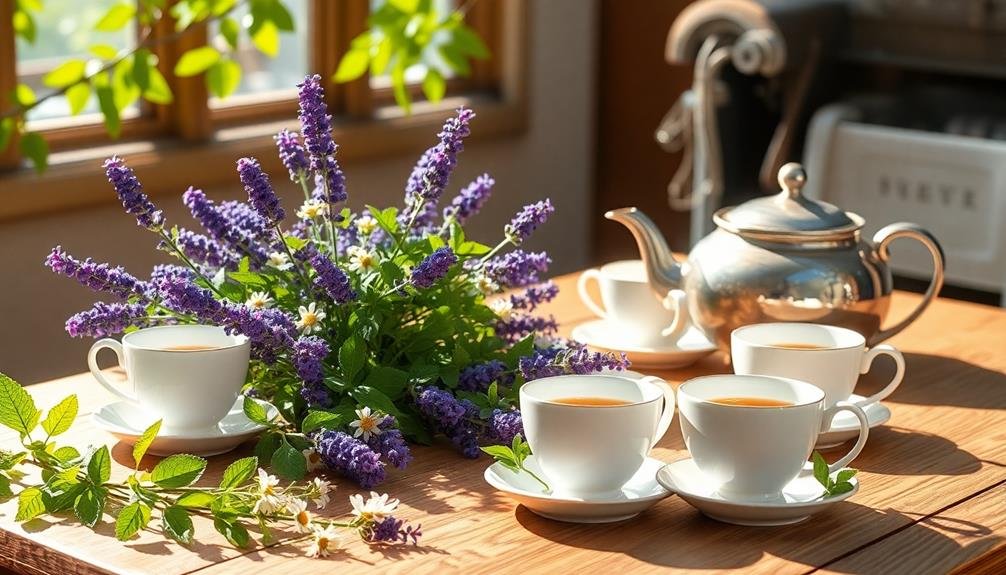
When blending wild lavender with other herbs, you'll want to contemplate their complementary profiles.
Think about how different flavors can enhance your tea experience, creating a balanced and aromatic brew.
Experimenting with various combinations can lead to delightful discoveries that elevate your lavender tea.
Complementary Herbal Profiles
Blending wild lavender tea with complementary herbs can create a delightful symphony of flavors and health benefits. By pairing lavender with other herbs, you can enhance its calming properties while adding new dimensions to your brew.
Here are three herbs you might consider:
- Chamomile: Known for its soothing effects, chamomile complements lavender's gentle floral notes, creating a harmonious blend perfect for relaxation.
- Lemon Balm: This herb adds a revitalizing citrus flavor and is renowned for its stress-relief qualities, making your lavender tea even more uplifting.
- Peppermint: With its invigorating coolness, peppermint contrasts beautifully with the warmth of lavender, creating a refreshing and aromatic experience.
When you blend these herbs, you're not just enhancing the flavor but also harnessing their synergistic benefits.
Chamomile can amplify lavender's sedative effects, while lemon balm and peppermint can uplift your mood and aid digestion.
Experimenting with these combinations can lead to unique blends that not only taste great but also cater to your specific wellness needs.
Flavor Pairing Techniques
Exploring flavor pairing techniques can elevate your wild lavender tea experience even further. By blending lavender with other herbs, you can create unique profiles that enhance both taste and aroma.
Start with herbs that complement lavender's floral notes, like chamomile or lemon balm. The gentle sweetness of chamomile balances lavender's earthiness, while lemon balm adds a revitalizing citrus twist.
Consider pairing lavender with earthy herbs like rosemary or sage. Their bold flavors can ground the floral notes, creating a well-rounded blend.
To add a hint of spice, mix in a touch of ginger or cinnamon. These spices can enhance the complexity of your tea while providing warmth.
You might also experiment with mint varieties. Peppermint or spearmint can invigorate your lavender tea, making it a delightful choice for a rejuvenating summer drink.
Remember, the key is to balance flavors; start with small amounts and adjust according to your preference.
Lastly, don't shy away from citrus. A splash of lemon or orange peel can brighten your tea, amplifying lavender's aromatic qualities.
With these pairing techniques, you'll transform your wild lavender tea into a personalized herbal delight.
Health Benefits of Lavender Tea
Lavender tea offers a soothing experience that extends beyond its fragrant aroma to provide numerous health benefits. When you sip on this delightful infusion, you're not just enjoying a pleasant taste; you're also supporting your well-being in several ways.
Here are three key benefits you might find interesting:
- Anxiety Relief: Lavender tea is known for its calming properties. Drinking it can help reduce stress and anxiety, making it a great choice for winding down after a long day.
- Sleep Aid: Struggling with insomnia? Lavender tea has been used for centuries to promote better sleep. The natural compounds in lavender can help you relax and fall asleep more easily.
- Digestive Support: If you often experience digestive issues, lavender tea may help soothe your stomach. Its anti-inflammatory properties can assist in alleviating discomfort and promoting overall digestive health.
Incorporating lavender tea into your daily routine can enhance your physical and mental well-being.
Brewing the Perfect Cup
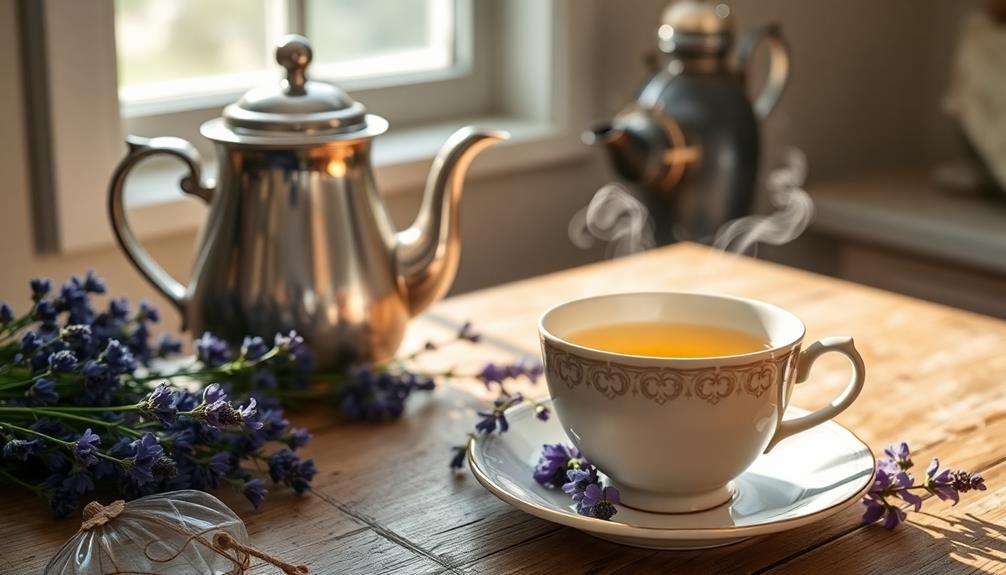
To brew the perfect cup of lavender tea, you'll want to pay attention to a few key details that enhance its unique flavor. Start by using high-quality dried lavender buds. Look for organic options to guarantee you're getting the best aroma and taste. A good rule of thumb is to use about one tablespoon of dried lavender for every cup of water.
Next, heat your water to just below boiling, around 200°F (93°C). This temperature extracts the essential oils from the lavender without scalding it. Pour the hot water over the lavender buds and let them steep for about five to seven minutes. This allows the flavors to develop fully, creating a fragrant and soothing cup.
Once steeped, strain the lavender buds using a fine mesh strainer or a tea infuser. This step guarantees you get a smooth cup without any floating bits.
Flavoring With Natural Sweeteners
Adding natural sweeteners can elevate your lavender tea experience considerably. Instead of reaching for refined sugar, contemplate these three delicious options that complement the floral notes of lavender:
- Honey – A classic choice, honey adds a rich sweetness and pairs beautifully with the herbal flavor. Opt for local varieties to enhance your tea with unique floral undertones.
- Maple Syrup – This natural sweetener brings a warm, earthy flavor that can deepen the overall taste of your tea. It's an excellent choice if you enjoy a slightly savory twist.
- Agave Nectar – With its mild sweetness, agave nectar blends seamlessly into your lavender tea without overpowering it. Plus, it's a great vegan alternative.
Experimenting with these sweeteners can help you find your perfect blend. Start by adding a small amount, tasting as you go, until you reach your desired level of sweetness.
Don't forget to contemplate the temperature of your tea, as warmer liquids can dissolve sweeteners more effectively.
With these natural options, you'll enhance the calming qualities of lavender, transforming your tea time into a delightful ritual.
Storing Dried Lavender

Properly storing dried lavender is essential to maintaining its vibrant aroma and flavor. To achieve this, start by choosing airtight containers, such as glass jars or vacuum-sealed bags. These will prevent moisture, which can lead to mold and spoilage. Make certain the containers are clean and completely dry before adding your lavender.
Next, keep your lavender in a cool, dark place away from direct sunlight and heat. Heat can degrade the essential oils, diminishing both the scent and taste. A pantry or cupboard works well for this purpose.
Label your containers with the harvest date, as dried lavender typically retains its best quality for about one to three years. It's a good idea to check for any signs of spoilage, such as an off smell or discoloration, before using it.
If you want to maintain the strongest flavor, consider storing lavender in smaller quantities, using what you need and keeping the rest sealed.
Creative Lavender Recipes
Lavender adds a unique twist to a variety of dishes and beverages, transforming the ordinary into the extraordinary. You'll love how this fragrant herb enhances flavors and creates delightful surprises.
Here are three creative ways to incorporate lavender into your culinary repertoire:
- Lavender Lemonade: Combine freshly squeezed lemon juice, water, and sugar with a lavender infusion. Let it steep for a rejuvenating, floral twist on a classic summer drink.
- Lavender Honey Glaze: Mix honey with dried lavender and a splash of lemon juice. Drizzle this glaze over roasted vegetables or grilled chicken for an aromatic finish that elevates your dish.
- Lavender Shortbread Cookies: Blend dried lavender with flour, sugar, and butter to create delicate cookies. These treats are perfect for tea time or as a unique addition to any dessert platter.
Experimenting with lavender can bring a new dimension to your cooking and impress your friends and family.
Don't hesitate to get creative and let your taste buds explore this aromatic herb's delightful possibilities!
Safety Precautions When Foraging

Foraging can be an exciting way to connect with nature and discover new ingredients, but it's essential to prioritize safety. Before you head out, familiarize yourself with the plants in your area. Invest in a reliable field guide or use a foraging app to help identify edible species. Remember, some plants can closely resemble toxic varieties, so always double-check.
When you're foraging, choose clean areas away from pollution sources, like roads or industrial sites. Avoid picking plants near pesticide-treated areas. Wear gloves if necessary, and wash your hands thoroughly after handling any wild plants.
It's also smart to carry a first-aid kit for minor injuries or allergic reactions. Start with small quantities when trying a new plant for the first time, as some individuals may have sensitivities. If you experience any adverse reactions, seek medical attention immediately.
Always respect local regulations regarding foraging, as some areas may have restrictions in place to protect native ecosystems. By following these precautions, you can safely enjoy the benefits of foraging and create delightful wild lavender tea blends without worry.
Frequently Asked Questions
Can I Use Dried Lavender From the Store for Tea Blends?
Yes, you can use dried lavender from the store for tea blends. Just make sure it's culinary-grade, as some varieties may not be safe for consumption. Enjoy experimenting with flavors and creating your perfect tea!
How Long Does Homemade Lavender Tea Last in Storage?
Homemade lavender tea lasts about one week in the fridge when stored in an airtight container. If you freeze it, it can last several months, but for the best flavor, consume it fresh.
Are There Any Caffeine-Free Lavender Tea Options?
Yes, there are plenty of caffeine-free lavender tea options available. You can enjoy herbal blends that incorporate lavender with other calming ingredients, ensuring you get a soothing experience without any caffeine jitters.
What Is the Best Time of Day to Harvest Lavender?
The best time to harvest lavender is in the morning after the dew has dried. This guarantees the oils are concentrated, giving you the freshest and most aromatic flowers for your tea blends or other uses.
Can I Grow My Own Lavender for Tea Purposes?
Yes, you can grow your own lavender for tea! Choose a sunny spot, guarantee well-drained soil, and water regularly. With proper care, you'll enjoy fresh lavender leaves to brew delightful herbal tea.
In Summary
Incorporating wild lavender into your tea blends can elevate your foraging experience and enhance your culinary adventures. By understanding the different varieties, practicing sustainable foraging, and experimenting with natural sweeteners, you'll create delightful, aromatic brews. Remember to store your dried lavender properly and always prioritize safety while foraging. So, gather your supplies, hit the trails, and enjoy the soothing benefits of your homemade lavender tea blends. Happy foraging and brewing!

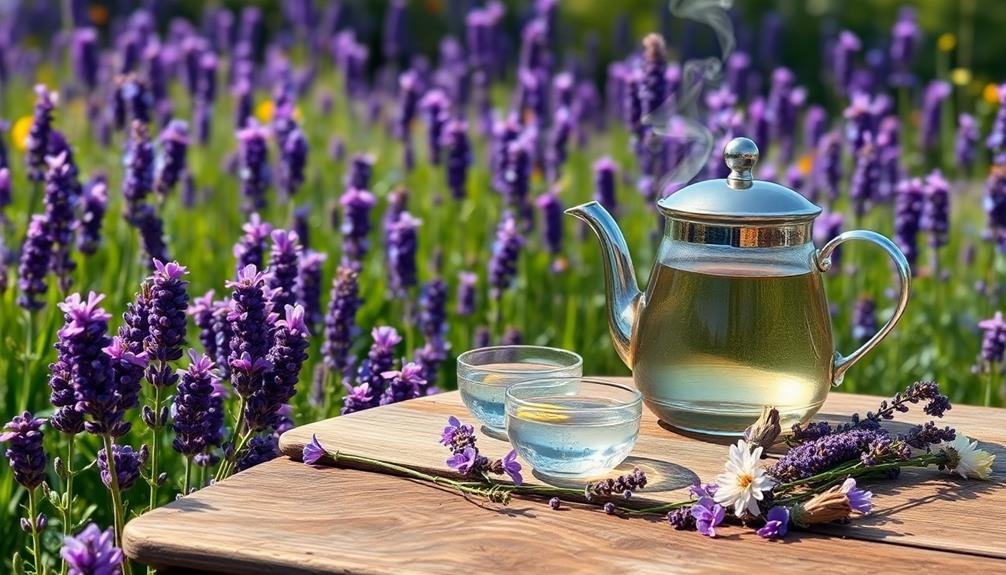
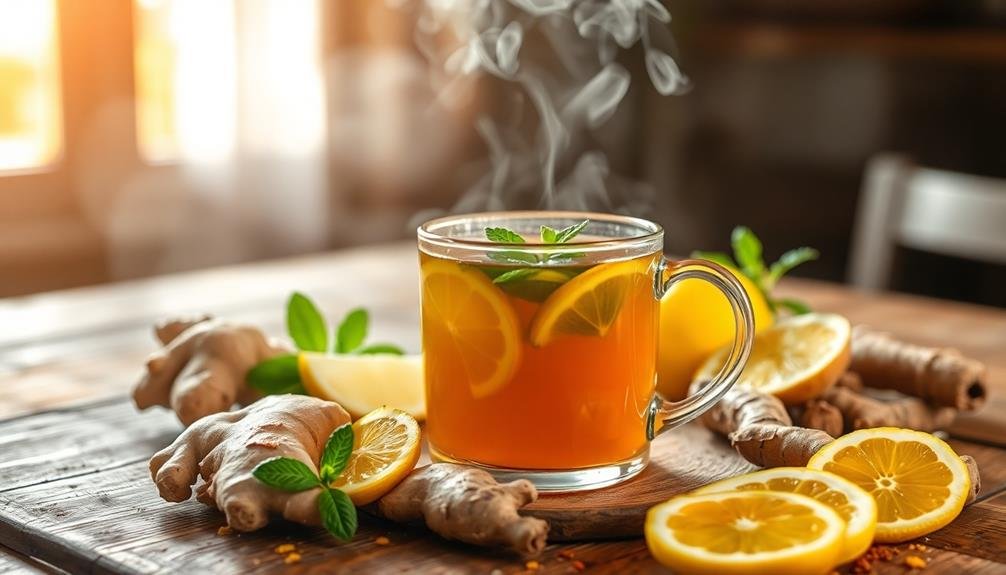
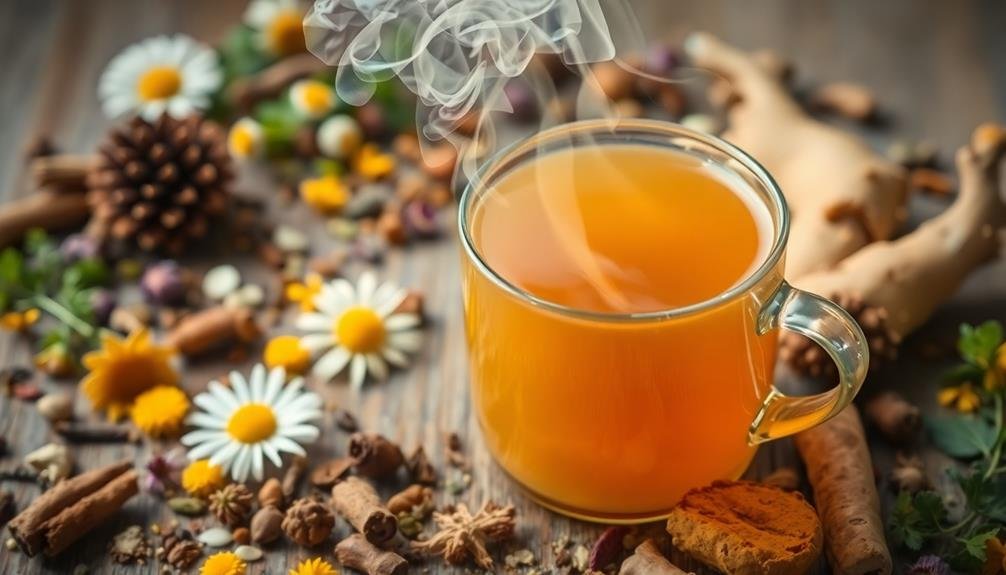
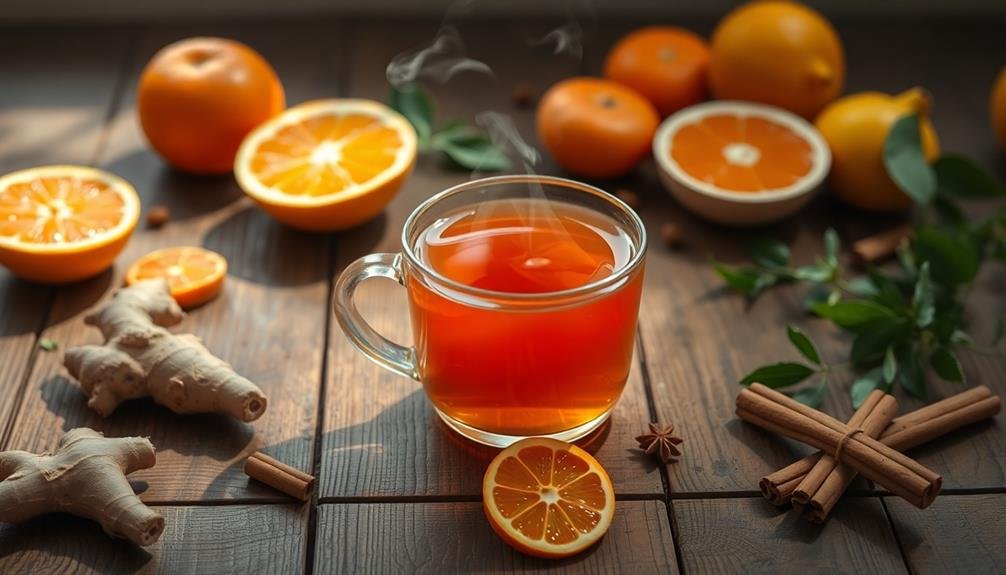
Leave a Reply